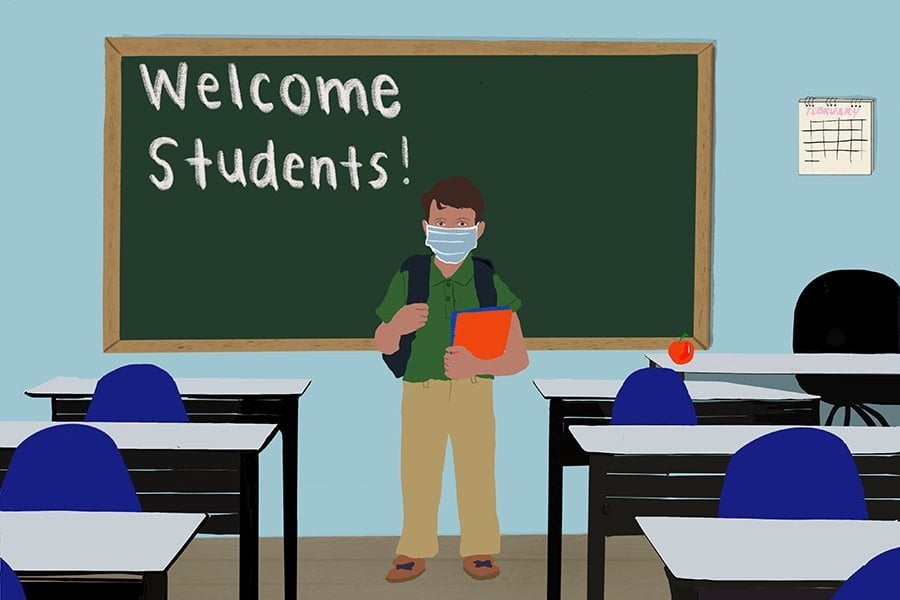A brand new schedule, COVID-19 policies, and students in “shutdown mode”: Three months into in-person school, ETHS teachers reflect
Daily file illustration by Emily Sakai
ETHS teachers welcomed back students back into the building for full in-person learning this August.
November 18, 2021
The past three months have been nothing short of a learning experience for teachers at Evanston Township High School as they readjust to full in-person instruction.
“Teachers are working their asses off and trying to do what’s best for students,” English teacher Anita Thawani Bucio said. “I’ve never worked harder than I have in these three months. But I’ve never experienced as much joy in my classroom as I have in these past three months.”
Bucio, along with her ETHS colleagues, returned to a full in-person schedule this August, following a transition to hybrid learning in April. Now, teachers are adapting to new safety policies and block scheduling, all while trying to support a student body recovering academically and emotionally from extended online education.
For chemistry teacher Terry Gatchell, shifting to in-person learning was a no-brainer. She felt confident returning with the high staff vaccination rate and mask mandate.
“There’s so many layers of protection that we have now (that) it wouldn’t make any sense not to be in the classroom,” she said. “I was overjoyed to be teaching live again.”
In addition to the mask mandate, COVID-19 safety policies include contact tracing, desks stationed six feet apart, assigned seating, daily sanitization of classrooms and health screenings for all staff and students.
In the month of October, four students and seven staff members tested positive, according to the ETHS COVID Dashboard. That’s coming from a student body of over 3700 and more than 270 staff.
Rick Cardis, president of the Teacher’s Union and an ETHS history teacher, attributed the low number of new COVID-19 cases to the ETHS community’s high vaccination rate.
However, he said the risk of COVID-19 exposure and infection is still a stressor for teachers. Low positivity rates don’t fully erase the concerns teachers face about COVID-19, he said.
“If you’re the one teacher who has been exposed, it really doesn’t matter what the experience of the school is broadly,” he said.
As the mother of a 19-month-old “pandemic baby” and a three-year-old, Bucio said it was hard to balance both the worries about endangering her children with her desire to do what’s best for her students.
“I came back in fear — because of my children, not because of me,” she said. “For me, anxiety is real.”
So for Bucio, returning to in-person teaching was bittersweet. Despite her anxieties, she was grateful to return. Coming back helped her realize she teaches better when she can connect with students face-to-face.
But getting back into the classroom brought a set of challenges even beyond pandemic concerns.
One major change is the shift to a block schedule. Classes now meet on alternating days for 85 minutes instead of the previous schedule’s 42 minutes per class. On Mondays, all classes meet at ETHS, but only last for 33 minutes.
Cardis said the new schedule is “dramatically changing the way we teach.”
“Some people have described it as feeling like they’re a first or second-year (teacher) again,” he said. “We’ve had three years of really dramatic change in how we do our job.”
The mask mandate for all students and teachers also changes classroom dynamics.
In her chemistry classes, Gatchell said it’s difficult to gauge her student’s understanding of the topic by facial expressions since everyone’s wearing masks. She can still see the eyes roll, though.
To accommodate for the new classroom dynamic, she said she takes extra time to sit down with small groups and teaches the class at a slower pace.
Cardis said another challenge this year has been bringing students up to speed on behavioral expectations. This is especially evident with freshmen, whose last full year of in-person education was 7th grade. Cardis said students have needed to relearn how to interact with their teachers and each other.
Bucio said she spent hours brainstorming ways to help her students come out of this year of isolation in what she described as “shutdown mode.”
“A lot of students of mine are still struggling,” she said. “They’re not okay. There’s been grief, there’s been loss, there’s been trauma, there’s been uncertainty. Students are still dealing with anxiety.”
Within her English classroom, she created spaces for students to express creativity by facilitating time for coloring or music games. She said she feels a heightened responsibility now to foster a community where students can be themselves: honest, thoughtful and curious.
Gatchell also has evaluated her curriculum after the pandemic. While she’s always incorporated real-world topics like climate change into her curriculum, she found COVID-19 related lectures were too overwhelming for her students when she tried to discuss disinfectants last spring. Now, she’s especially cognizant of how her lessons can impact her students, she said.
Cardis said students experienced trauma beyond the pandemic, including viewing highly publicized police killings of Black Americans and a surge in anti-Asian hate crimes last year. That’s shifted the priorities of teachers like Cardis, who are now trying to not only provide lessons, but also space and support for students’ mental health.
“There’s been a lot of focus this year on social and emotional learning, and trying to take care of students, mental health and well-being,” Cardis said. “That’s something that’s been necessary for a long time, but the things that have happened over the last couple of years – COVID and otherwise – have helped us to focus on that more.”
Email: isabellebutera2025@u.northwestern.edu
Twitter: @isabelle_butera
Related Stories:
— “Climate justice now”: ETown Sunrise and ETHS students walk out for CARP implementation
— ETHS administrators address questions about 2021-22 academic year in webinar


